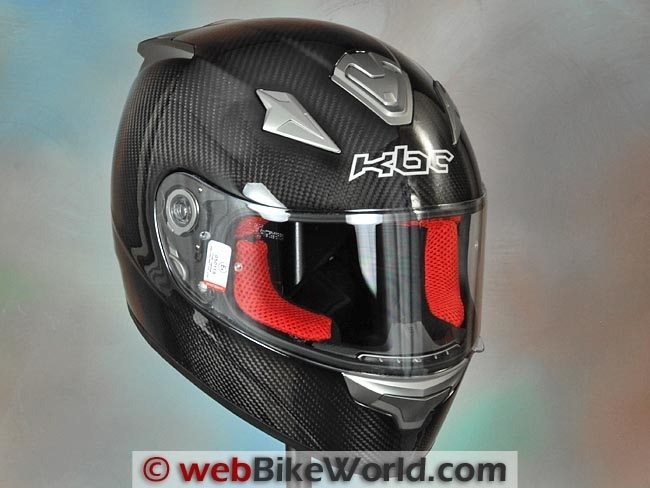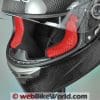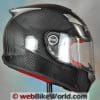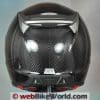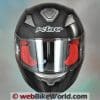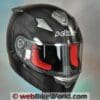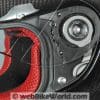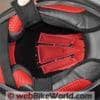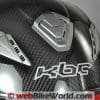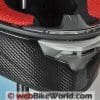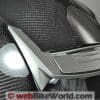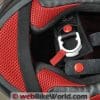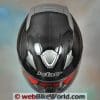The new KBC VR4R Carbon fiber helmet is a real beauty.
It’s also about the least expensive carbon fiber motorcycle helmet available today.
But the design is somewhat compromised by flimsy-feeling vent hardware, which is unfortunate and something KBC needs to address.
I’m not sure exactly when carbon fiber motorcycle helmets first appeared.
The HJC AC-12 Carbon (review) was introduced on webBikeWorld back in 2006, and it was one of the first mass-market carbon fiber motorcycle helmets in the world.
Carbon fiber is a natural for motorcycle helmets, where low weight is important. The carbon fiber itself also makes a cool-looking helmet without having to resort to garish paint or distracting graphics!
We’ve been reviewing carbon fiber helmets ever since and the technology has come a long way during the last 6 years or so.
It’s not that easy to make a good carbon fiber helmet and traditional polycarbonate molding construction techniques are completely different.
If you’re interested in learning more, be sure to read the Editor’s interesting article about his tour of the Nolan Helmets factory, which features several videos illustrating how helmets are made and the differences between DOT, ECE and Snell safety standards.
We’ve also reviewed several KBC helmets in the 12+ years of webBikeWorld helmet reviews. First up was the KBC VR-1 (review), which was reviewed back around 2003.
In the motorcycle helmet manufacturer hierarchy, KBC probably slots just below HJC as a “2.5 tier” level manufacturer.
Their quality is somewhat better than “third tier” companies like AFX, but not quite at the level of HJC, which I consider “second tier” (first would be Arai, Shoei, Shark and perhaps others).
Those are all my totally subjective rankings, of course, and probably irrelevant for purposes of this review.
KBC usually produces fewer helmet models than other companies (far fewer than HJC, for example) and their 2012 lineup is no exception.
In the U.S.A., the current KBC lineup includes only the VR4R at their “Race Wear” helmet. It’s available in the “raw” carbon fiber shown here or as a U.S. Olympic Replica graphic version. Perhaps they’re sponsoring the U.S. bobsled team in the coming Olympics?
It’s also one of the least expensive (or possible the least expensive) “mass-market” carbon fiber motorcycle helmets you can buy.
The current KBC “Street Wear” line includes a single helmet, the VR, which is available in two colors. And finally, their “Dirt Wear” line includes a single helmet also, the VMX, in one color.
That’s a very small lineup for a motorcycle helmet manufacturer, but it pretty much covers the spectrum. Now you’d think with only 3 helmet types to manufacture that they’d have time to perfect all the little details that make the difference between “good” and “great”.
Unfortunately, KBC really missed the boat on the vent design of the VR4R, however. I’ll explain more as we get to the Ventilation section. So let’s take a look…
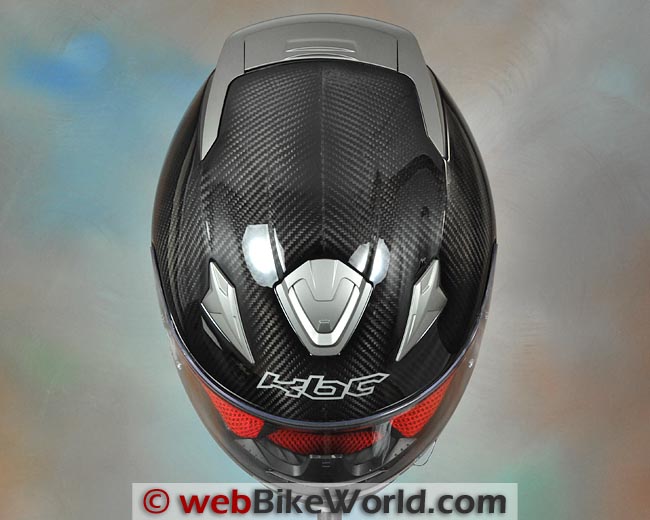
The KBC VR4R Carbon: Paint, Graphics and Overall Quality
No question about the shell design and the quality of the carbon fiber on this helmet — it’s a beauty!
It’s usually more difficult to mold carbon fiber into complex shapes, compared to polycarbonate helmet shell molding and construction. But the VR4R has some very nice lines, with a subtle upsweep along the sides and a pair of shallow creases outlining the exhaust vent in the rear.
The quality of the carbon fiber is first-rate and about as good or better than we’ve seen on any carbon fiber helmet in recent memory. The helmet is also covered in a thick clear coat, which makes the carbon fiber weave simply pop.
The difference between “great” carbon fiber and the rest is where the seams meet, and the seams on the VR4R are perfect. Not a single weave is out of place and that is very difficult to achieve.
The molding along the bottom of the helmet is also nicely designed, with an upswept rear holding a pair of screened exhaust vents that are for show, but they look good.
The face shield design is very nice and it works well, forming a tight seal against the eye port. More about that in an upcoming section also.
The only overall quality letdowns on the VR4R are the quality of the vinyl on the bottom of the helmet, which looks a bit cheap and immediately started to show wear, and the quality of the vent hardware, as I mentioned above.
I guess they wanted to save some money on the vinyl…although it doesn’t take much to throw on some decent fabric or other material. But that vent design is problematic.
The top vents are acceptable, but the chin vent and the rear vent on this helmet are very loose and feel like they’re about to come off in my hand. That’s really too bad, because it affects the overall impression of this helmet. Anyway, more on that in a bit.
Score: The VR4R is a tough one to rate for overall quality. The helmet shell is outstanding; the liner I’d rate as excellent but the vent hardware is rated as poor. See the Summary Table at the bottom of the page for a description of our rating system.
KBC VR4R Carbon Helmet Fit, Internal Shape and Liner
We’ve noticed recently that the internal shapes of many new motorcycle helmets seem to be converging on a classic “Neutral” profile. This seems to be a trend, broken by the VR4R.
The VR4R has more of a “Neutral” to “Slight Narrow” internal shape, using the webBikeWorld helmet shape classification terminology. This helmet is a size large and KBC says it should fit a 59-60 cm head.
That’s about right, but I think 60 cm is the maximum for this one if you’re anything other than a “Neutral” to “Slight Narrow” head shape.
Since that is apparently the most common American head shape, it shouldn’t be a problem for many owners and, in fact, we’ve been receiving many emails recently from webBikeWorld visitors asking about this type of helmet, so if you’re one of them, the VR4R deserves a serious look.
The removable liner and padding is comfortable but I wouldn’t say it’s exceptional. It’s serviceable and decent; the padding is about average and the fabric is fairly soft, with average-feeling materials about the quality of an AFX helmet.
The red contrasting mesh material is used as a stylistic accent, but unfortunately they used it in the front of the cheek pads also, which I find rather distracting when I’m riding. Black or some dark, neutral matte color would be better here in my opinion.
The ear pockets are heavily padded but the padding can be removed separately to fit speakers.
Although the padding triangles actually have an advantage for mounting speakers; the hot tip for mounting helmet speakers is to try and get them as close as possible to your ears for best results.
The narrow lip around the bottom of the VR4R is suitable for the standard type of motorcycle intercom helmet mount, such as those used on the new Interphone F5 (review) or the also-newSena SMH5 (review), either of which work very nicely with the VR4R.
The fit of the “Slight Narrow” internal shape mean that eyeglasses are a tight fit for round heads but shouldn’t be a problem for others.
The helmet has a large chin curtain but the shape of the neck roll around the bottom is also somewhat oval, so again, the best fit will be with head shapes that match.

More information on helmet fit can be found in the webBikeWorld Motorcycle Helmet FAQ page, along with the chart that lists the helmet weights of webBikeWorld reviewed helmets and also by shape on the webBikeWorld Motorcycle Helmet Shapes page.
Score: I’ll give the KBC VR4R an “Excellent” rating for fit, comfort and internal shape. The padding and liner feels comfortable and the helmet should fit neutral to slightly narrow head shapes.
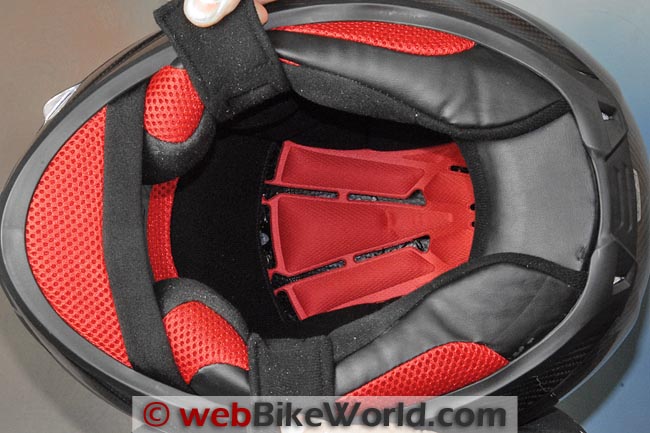
KBC VR4R Eye Port,, Face Shield and Visibility
The view out the VR4R eye port is about average in the horizontal plane and slightly better than average in the vertical. That red fabric on either side of the cheek pads is really distracting though in my opinion. It’s a case of style over function and apparently the stylists won.
The eye port has a full-surround gasket and it forms a tight seal against the face shield. The face shield removal system is excellent and easy to use.
It has some sort of spring-loaded device that keeps the face shield tight against the gasket. The face shield also snaps smartly through its four detents and it has a first opening position for defogging that works well, although it’s a slightly larger opening than is optimal for this purpose.
The face shield removal system deserves recognition, as it works very well and it’s easy to use. Push up on a lever and the shield pops out. This is illustrated in the video below.
The face shield measures 2.11 mm on this helmet and the VR4R comes equipped for a Pinlock anti-fog insert (review), although none is provided with the helmet, another cost-cutting measure no doubt.
A slightly smaller than average lift tab is located at the lower left of the face shield.
The VR4R passes the webBikeWorld face shield “leak down test”, which involves pouring water along the top of the closed face shield to test for leaks. No water leaked into the eye port past the gasket.
The water is directed down along the outside of the gasket and eye port and exits out the bottom of the face shield.

Score: I’ll rate the VR4R face shield and the design of the eye port as an “Excellent” in this category.
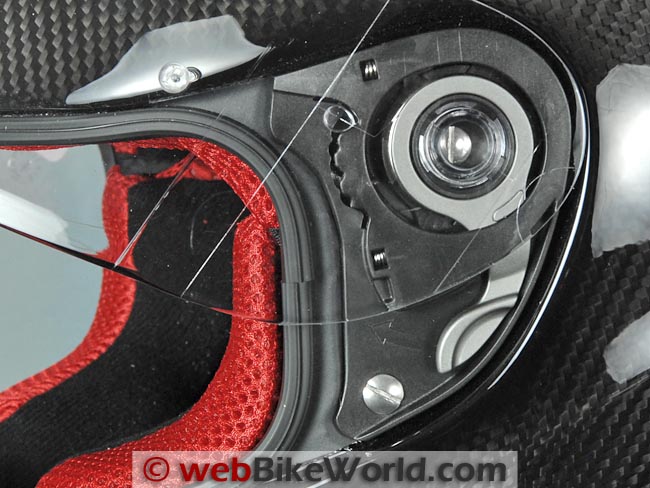
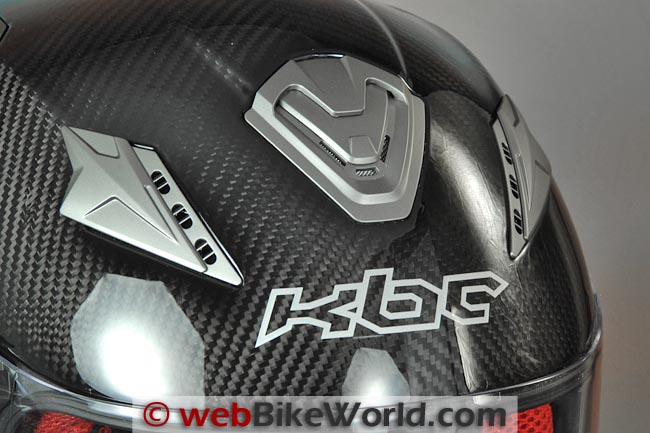
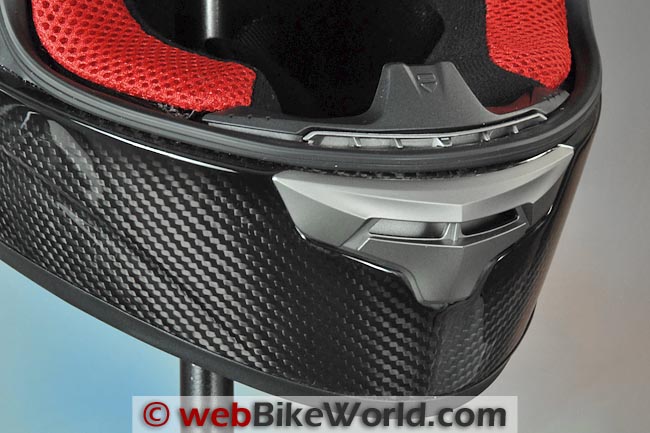
KBC VR4R Ventilation and Air Flow
The VR4R has a total of five vents to open or close, which are probably about three too many. But the biggest problem with the vents is the design of the chin vent and rear exhaust vent covers, which have a very loose and flimsy feel, as illustrated in the video below.
The quality of the vent covers is a disappointment, compared to the overall quality of the helmet shell. The chin vent slider is loose and the plastic feels thin. It has very weak detents, which allow it to flop back and forth.
The top vents are better, although they use the same type of thin plastic. But at least the detents feel more solid. The center vent on top has at least a solid feel and the two side vents click open and closed.
But the top surface of the side vents is too slick and the vents open towards the sides of the helmet, not forward and back, and this combination makes them both difficult to find when wearing gloves and to operate.
You don’t want to be messing with three separate vents on top while you’re riding, meantime trying to locate the slippery flat vent cover and then figuring out which way to push it to get it open. It’s a safety issue.
The rear vent is a real problem. KBC should have made the rear exhaust an “always on” system instead of the overly-complex, very flimsy vent they designed.
The cover literally feels like it’s about to come right off in my hands and the detents are so weak that the cover flops around in its recess — this is illustrated also in the video below.
You’d think with all these vents that the helmet would have good air flow, but it’s average instead. In terms of performance, the chin vent is a bit weak.
There are some perforations inside the chin bar but they’re backed by EPS foam, so not much air comes through. The air from the chin vent flows up in back of the chin bar, but the air flow is weak.
Look inside the helmet and you’ll see the holes through the EPS for the top vents, but unfortunately the air coming through the center vent on top has a complicated path to follow, which diminishes its effectiveness.
The two side vents have a direct path through the EPS; shine a light through and you can see the vents, but for some reason — probably the shape of the vent holes on top — there isn’t as much air coming through as you might expect.
So overall, I’d have to rate the VR4R vent hardware as “Poor” and the air flow as average. It’s a real shame and it affects one’s impression of the helmet. If KBC can fix this quality issue — and make the vents more effective — they’d have a real winner here.

Score: I’ll give the KBC VR4R ventilation system a “Neutral” rating for effectiveness.
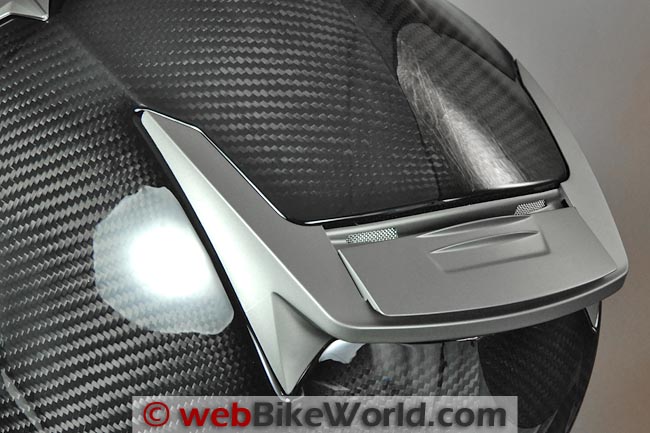
KBC VR4R Sound Levels
The top vents on the VR4R give a wind rushing noise when the rider is sitting up straight, but the noise disappears as the head is tilted forward. Otherwise, the noise levels are about average to slightly better than average for the VR4R.
Depending on the match between the rider’s head and the helmet shape, there may be some air noise produced towards the lower rear of the helmet.
There’s a split line in the liner padding in back of the ears, and this seems to bring some noise from the rear of the helmet up into the back of the helmet, adding to the overall sound levels.
So overall I’d rate the KBC VR4R as about average, with some general wind noise around the top vents in certain conditions and the possibility of noise coming up from in back of the helmet that might be solved by thicker or redesigned padding.

Note that our helmet evaluations are a combined effort of several riders over time on different types of motorcycles with and without windscreens.
Evaluators wear correctly fitted, high quality ear plugs (even when evaluating motorcycle intercom systems).
Always protect your hearing when riding a motorcycle. See the wBW Earplug Reviews for more information on choosing and wearing earplugs.
Note also that perceived noise levels will vary, depending on the individual.
Noise can be caused by many factors, including helmet fit, the type of motorcycle and windscreen, wind speed and direction and even the rider’s clothing.
For more information on helmet noise, visit the wBW Motorcycle Helmet Noise page.
Score: I’ll give the KBC VR4R a “Very Good” rating for average overall noise levels.
Helmet Weight
The KBC VR4R is one of the lightest helmets reviewed on webBikeWorld, with a weight of 1436 grams in this size large (3 lbs., 2-1/2 oz.). This puts it just in the top ten lightest helmets we’ve reviewed, just bumping the SCHUBERTH SR1 (review), at 1438 grams to 11th place.
It also is another illustration of how light the Lazer Monaco (review) flip-up helmet really is in comparison.
The Monaco weighs 1406 grams (3 lbs., 1-5/8 oz.), making it the lightest flip-up motorcycle helmet we’ve ever reviewed by far and one of the lightest helmets of all time of any type.
It’s much more difficult to make a lightweight flip-up helmet, with all its moving parts, so this is a real accomplishment.
Compared to some other full-face helmets picked at random from the webBikeWorld Motorcycle Helmet Weights page, the VR4R Carbon compares well against the carbon fiber Akuma Phantom II MFR (review) (XL), which weighs 1367 grams and the Nexx XR1R (review) (L, not carbon fiber) weighed 1382 grams.
The bottom line is that the carbon fiber shell of the KBC VR4R is not only good-looking, it definitely reduces weight.
Note also that all of the helmets reviewed on webBikeWorld have been weighed and the weights are available on the wBW Motorcycle Helmet Weights page, along with a chart that lists the helmets by weight and shape on the wBW Motorcycle Helmet Shapes page.
Score: The KBC VR4R gets an “Outstanding” rating for very light weight with outstanding balance.
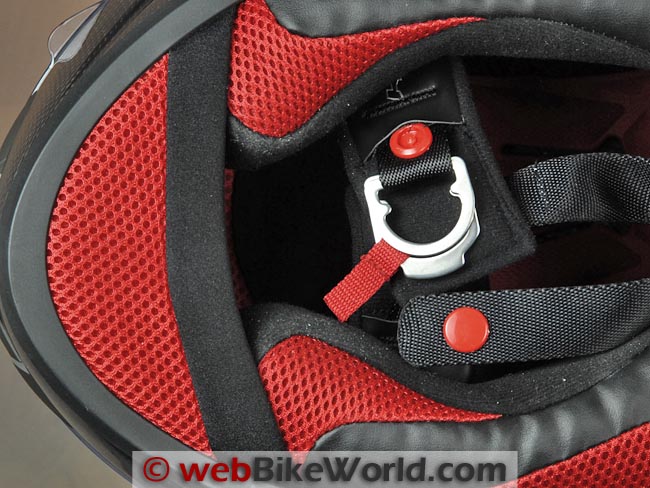
Miscellaneous
The VR4R has a double D-ring chin strap system. There’s a plastic snap on the left to secure the loose end, but the left side of the strap that holds the D-ring is about 10 mm too short.
This makes it more difficult than it should be to thread the chin strap through the D-rings and also to reach up and snap the extra length.
The helmet meets the DOT and ECE 22.05 safety standard and is ACU Gold approved.
Warranty
KBC helmets have a five-year warranty, according to the company.
| webBikeWorld Overall Opinionator: KBC VR4R Carbon | |
|---|---|
| Picks… | …and Pans |
|
|
Conclusion
The new KBC VR4R Carbon has a very nice, solid-feeling shell with outstanding carbon fiber quality. The face shield design is also very nice and the removal system works really well.
The helmet looks great, but it’s let down by the vent hardware, which feels flimsy and is not up to the standards of the rest of the helmet. Also, the vinyl on the bottom of the helmet feels cheap — there’s no other word for it — and ours started to show wear almost immediately.
The VR4R Carbon is one of the least expensive carbon fiber helmets available, and a redesign of the vents shouldn’t cost any more.
In fact, KBC could save money by eliminating the moving parts in the rear exhaust vent, which aren’t necessary. If they can do this, the VR4R Carbon would move from average to outstanding in short order.
| wBW Review: KBC VR4R Carbon Fiber Helmet | |
|---|---|
| Manufacturer: KBC Helmets (defunct) | List Price (2012): $379.00 |
| Colors: Carbon fiber or U.S. Olympic colors. | Made In: China |
| Sizes: XS-2XL Shell Sizes: Unknown | Review Date: April 2012 |
|
Rating Scale is subjective: Unacceptable, Poor, Neutral, Very Good, Excellent, Outstanding.
|
|
Note: Item provided by a retailer, distributor or manufacturer with these Terms and Conditions.
Owner Comments and Feedback
See details on submitting comments.
From “J.W.” (May 2013): “Some comments of the KBC VR4R carbon fiber helmet. First, it looks great and is noticeably lighter than my Shark RSI (review). The vents are indeed goofy but I leave them open all the time anyway so it’s not an issue for me.
This is really a snug fitting helmet and I had to replace the cheek pads with a size XL to get a little more room. The replacement pads are black and gray so anyone who doesn’t like the red pads can replace them for about 20 bucks.
It’s also tricky to fit glasses so anyone who wears them might want to consider a different helmet
The face shield removal system is the best ever but what I really like is that the face shield has a really positive ratcheting system that leave no doubt that the shield is closed.
I have only worn the helmet to ride to work, about 40 minutes each way, and haven’t noticed any hot spots or other fit issues, however, the helmet is too snug to wear a Sliks helmet liner (review).”
UPDATE From “J.W.” (June 2013): “Couple of observations after a month or so of use. The bolts that hold the ratchet plates to the helmet (2 on each side) work loose and fall out. they should be removed and re installed with Loctite.
I got caught in a downpour on the freeway this afternoon. The face shield was 100 percent watertight. Very impressive.”
Another Update from “J.W.” (August 2013): “The helmet is a tough one. Shell finish, fit and face shield function are outstanding. Face shield does not leak. Period. I ride in the mountains a lot where it rains almost every afternoon and that is a big deal.
The helmet is noticeably light and fits farther down on my head than my Shark RSI which barely covers my chin. If you need to be able to open and close vents while riding, buy another helmet.
Also, the vinyl trim on the bottom of the cheek pads has started to show signs of wear almost instantly. I have had helmets for years and have never seen that happen. So that’s pretty much it. I bought a mirrored visor which looks way cool.”


